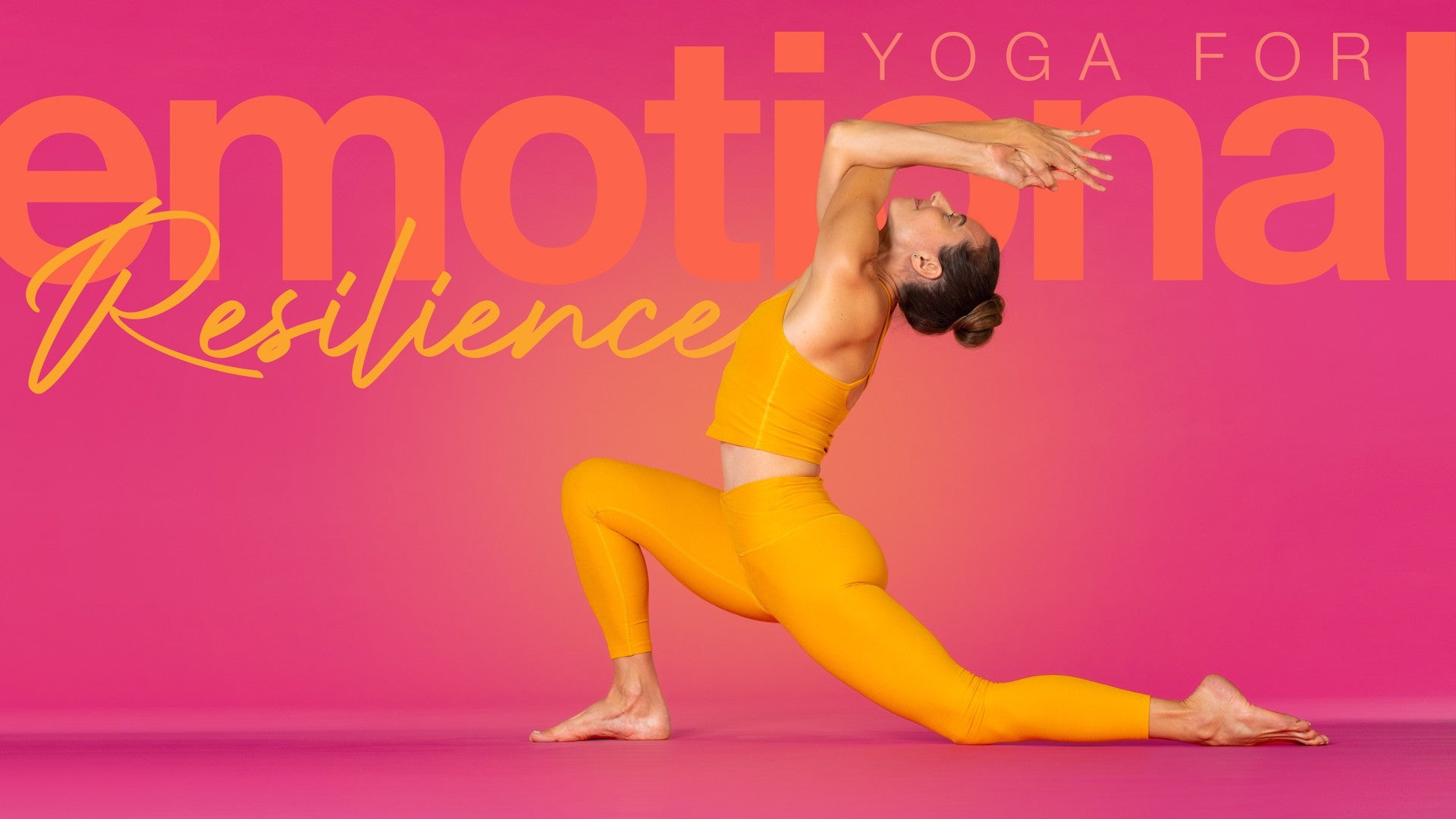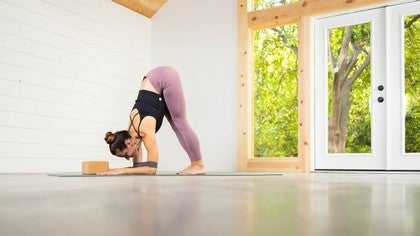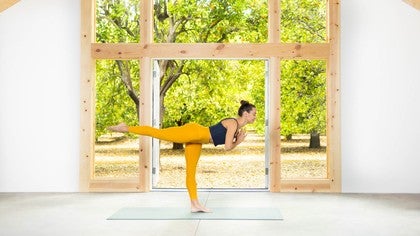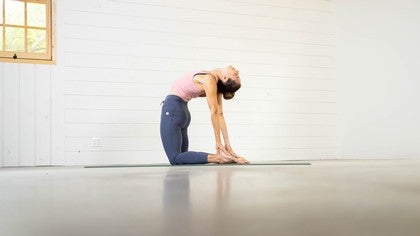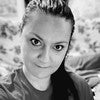Description
Sometimes life doesn't allow us to take a break, and the kindest thing we can do for ourselves is to muster our courage, endure stress, and meet challenges. Our kidneys govern our will, stamina, and destiny. Maria leads a challenging and inspiring class entirely composed of long holds in fewer poses to help balance the kidneys, and prove to yourself that you can sit in the fire, you can rise to challenges, you can do hard things - even if you don't want to! We explore this feeling by holding Down Dog, Planks, Dolphin, Handstand, and Forearm balance. You will feel strong, confident, centered, and focused.
See attached pdf to learn more about kidney imbalance, and for journal prompts to help you remember your purpose, find confidence in your path, and strengthen your will.
About This Video
Transcript
Read Full Transcript
Welcome, today's sequence is to strengthen the kidney will. So we're not going to do a lot of postures today, but we'll be doing less postures that are really challenging and we're going to be holding them for longer periods of time. The reason we're doing that is so that we can really strengthen ourselves, build our endurance and build our ability to stay within the discomfort and to work against the resistance that comes up as we face our discomforts. So if you can grab one strap, one block, and a bolster, you'll be all set for practice. So we'll lie down on our backs, bring our feet together, knees apart, for a reclined Baddha Konasana.
You'll lie down on your back, take your right hand to your belly, left hand to your heart. Close your eyes and start to connect with your breath. Let the inhale and the exhale be soft and smooth and even. Soften any tension in the jaw, the cheeks, the shoulders. Let the body get heavy.
Just connect with your heart and connect with your inner strength. What makes you special? What's important to you? What's your purpose and what are you here to do? And if it's really, really important to you, you will do it.
I used to say, we always have 10% more than we think we have. But I've come to realize that it's actually more like 50 to 100% more than we think we have. We don't believe in ourselves enough. And set an intention for yourself, for your practice. So you'll reach for your block, straighten your legs, flex the feet, and have your legs strong like you'd be standing on them.
Take the block between your hands, reach the arms straight up over your shoulders, press the hands into the block, start to firm your lower ribs down towards the mat, pull the belly in, and we're going to take the arms up overhead. As you take the arms up overhead, straighten the arms, wrap the outer upper arms towards your face. And they may not go very far. If they go all the way to the floor, chances are you're losing your form and you're starting to let your arms turn in, maybe even bending the elbows. Keep the priority on keeping the arms straight and wrapping the outer upper arms towards your face.
And breathe into your chest, keep firming the ribs in. We're going to move into some challenging poses like downward facing dog and handstand. And this alignment will become really, really important. So I want you to remember what you're doing here and try to integrate that as we go into more advanced asanas. Press the hands firmly into the block, wrap the outer arms to the face, straighten the arms and breathe.
You can probably start to feel some of the muscles that are firing to hold this alignment. And then we'll bend the elbows, I don't want to fatigue you too much yet. Set the block down, bend your knees, roll over to your side, press yourself up to seated. And we'll come into a downward facing dog. If it's really hard to straighten your arms, you can use a strap around your upper arms.
You'll just measure it out so it's about your shoulder distance apart and you'll bring it right above the elbows and the purpose is to keep your arms straightening. So you don't want to press out into the strap but instead you want to straighten the arms so much that the strap almost comes loose. And then you'll bring your hands to the floor, sit your hips back to your knees, this is about the distance that you'll be, inch your fingers forward, lift your hips up, curl your toes under and press back to downward facing dog. I'm going to lose the strap because it's kind of uncomfortable for me but use it if you need it. Coming into your downward facing dog, press the mound of your index finger down, mound of the thumb down, and as you press the roots of the fingers, start to feel the forearms lift up away from the floor so you're getting lighter in the heels of your hands, simultaneously wrap the outer upper arms around towards your face, press out through your heels and then push the floor away from you so that you're lengthening your side bodies.
Once you've found your downward facing dog, stay there, no fidgeting or minimize the fidgeting. In building endurance, building our will, we stay focused, we stay still, and we weather the storms as they come up. Find slight sense that you're both trying to bend the arms so you engage the biceps but also hug the triceps in so you're straightening the arms too, finding that isometric contraction. And then we just breathe. We will all come up to a point where we're ready to come out, ready to come to child's pose.
And although there are many times in life where we want to be gentle with ourselves, where we want to give ourselves a break, sometimes in life we don't have that option, sometimes the kindest thing we can do for ourselves is to push forward, to not take the break, to work through the hard things that we don't want to face. To sit in the fire, build our confidence, prove to ourselves that we are good enough, we are more than enough, and we stay connected to our purpose, what it is we're here to do. We first enter into downward dog. Oftentimes we'll hear our teachers say it can be a resting pose, and that's true after a pose like handstand or backbends, it feels much more gentle. When we hold it for a longer period of time, you start to see, wow, my biceps are working a lot, my shoulders are starting to get tired, maybe your hamstrings.
See how much you can sit with those discomforts, breathe into them, and focus on the breath, focus on the I can and I will, and use this as an opportunity to stay present. You start to feel stressed, you recognize it's just a pose, it's just a tired muscle, it's just an emotion, it's just a challenge, and we're almost there. Go ahead and stretch out a little more, find a slightly deeper expression of your downward facing dog, and then we'll come down to our knees and we'll take a nice rest in child's pose. So after we go through the fire and we've challenged ourselves, it's always nice to give yourself a break too, some time to restore. Maybe roll out your wrists if it felt like a lot of pressure on your wrists.
Relax your shoulders, your breath. And then look forward to your hands, curl your toes under, and we're going to come to plank pose. So straighten your legs, reach out through your heels, keep the kneecaps lifting up the thighs, tailbone reaches to the heels, lower belly pulls in, you push down through the mound of the index finger and press up between the shoulder blades, but then at the same time reach the chest slightly forward for plank pose, which is a challenge, and we often use it really as a transition. We don't hold plank pose very often in our practice, but we're going to stay with it. Maybe soften the elbows just enough so you're not locking them out, especially if you tend to hyperextend.
Keep digging deeper. You can do this, you will do this. Absolutely necessary, you can bring the knees to the floor. Still challenging even with the knees on the floor. And if you have to come out of the pose, come right back in.
We're using these postures to prove to ourselves that we can do hard things. We can rise to the challenges life presents. Even if we don't want to. If your legs start to get lazy, see if you can get them stronger, tuck your tailbone under more, and breathe deeper. You might start to sag towards the floor a little bit, push the floor away from you, pull the belly in, give it four more deep breaths in and out.
One more, and bring your knees to the floor, sit your hips back and find your child's pose. Get your breath if it got fast, relax your arms, shoulders. Roll your wrists if they feel a little achy or tired. And then we'll come up. We're going to work on a dolphin pose, which is on our forearms, so you might need that strap now.
We'll bring it above the elbows, and you'll also take your block, because we want to try and get our forearms parallel. We'll place the block down, hands flat, curl the toes under, and we're going to lift the hips up into a pike position. You have the option to stay a little bit more like downward facing dog here, or start to walk the feet in, and come up high onto the tiptoes. Downward facing dog is a little gentler, but still challenging. Breathe, and we'll press the inner hand to the floor, again wrap the outer upper arms towards your face, and just let the head drop so you're not straining the neck, especially because we're in a longer hold.
You'll look back between the shins and breathe. Another nice thing that happens when we hold postures for longer than we want to is we start to see what muscles are fatiguing, and we might even start to see imbalances from side to side, so just pay attention to that. One side might be working harder than the other, and maybe it's because one side is less developed, or it could be an imbalance in your alignment and posture. Keep pulling the belly in, front ribs in. If the legs need to be a little bent here because of hamstrings, that's okay.
This is obviously a practice that's pretty intense for the upper body, but hamstrings are pretty important here as well. During flexibility and hip flexion, and I usually practice more vinyasa which is a lot of movement, sometimes it's nice to have a more slow, sustained practice, especially if the mind is really racy. This is a really good way to still the mind. Stay in the fire. You can walk your feet back a little bit if you brought them forward, and then come down to your knees and sit back on your heels for a child's pose.
If you want to, you can get rid of the strap. You might need it for the next pose, but it's not crucial. Same with the block. Okay. Setting up for forearm plank.
We'll bring our forearms to the floor. It's okay if your hands come a little closer. We try to get the forearms parallel, but if you need your hands a little closer, that's okay. And we'll curl the toes under, straighten the legs, tuck the tailbone under, reach the chest forward, but keep pressing down into the floor so you don't collapse between the shoulder blades. We're going to hold and breathe, belly pulled in, legs strong and straight, breath nice and deep.
In some ways, this is probably the most challenging pose we've done so far, but it's also really challenging because we've already done three really challenging long holds. So a lot of the muscles are starting to get fatigued, so we have to dig a little deeper, but know that you can do it. Even if for some reason you need to come out, take a moment, come back in, and absolutely don't beat yourself up. Use it as inspiration to train, to come back tomorrow or the next day, and do it all over again. The more we practice, the stronger we get.
Holding for longer than you want to. Doing it more than you think you have. And then bringing the knees to the floor, reaching the hips up and back, coming into child's pose, which will feel really good right now. Soften the breath. See if you can slow it down.
And then we'll come up to seated. We're just going to add a little bit of shoulder opening. Just interlace your fingers and straighten the arms back behind you. Lift the chest up. Raise the right arm up, bend the right elbow, take hold of the elbow with your left hand.
Reach out through the elbow as you side bend to your left. And then release that. Bend the left elbow, grab a hold of the left elbow with the right hand, side bend over to your right. And then release that. And we'll come over to the wall.
We'll take our handstand now, and we're going to hold it for a while as well. If handstand isn't available to you, you can try. Just try kicking up and keep kicking up. Or you can do downward-facing dog. Repeat that again and do another long hold.
If when you jump up into handstand, you have a tendency to bend the elbows or you're newer to practicing handstand, then I want you to keep a strap around your elbows so that that holds them straight and you don't clunk down on your head. We'll take our hands pretty close to the wall. Come into a downward-facing dog. Turn down dog, you'll take one foot forward, bend that knee, and you'll kick up till you reach the wall. You have the option to keep the heels on the wall.
You can bend the knees a little bit or keep the legs straight. For today, really, the purpose is more so to just stay in the pose than it is to balance. We're working on strengthening the muscles that will hold us in handstand. And you can even let the ears be in line with the arms rather than looking down to the floor. Pull the front ribs in, reach the tailbone to the ceiling, and breathe.
At this point, we've worked all these muscles in the previous postures so you're starting fatigued. Just try to stay with it. If you have the strap, you probably have to keep your head a little closer to the wall to make space for the strap around the arms. Keep the front ribs in, belly pulled in. Starting to feel heavy in the wrists, see if you can press the roots of the fingers a little more.
And you might need to come down and put a towel or a blanket underneath the wrists. Very low towel or blanket or fold over your mat. Or just take a break and do downward-facing dog instead. And then we'll slowly come down. And let's take a child's pose again.
For sure now roll out your wrists, maybe even bring the backs of the hands together to stretch them in the opposite direction. Our final challenge for today, final challenge on our mat for today, is forearm balance. Again taking the strap around the elbows if you need it. Bring the block between the hand and the strap will go right above the elbows. And then the hands flat on the floor, around the block.
Curl the toes under like a dolphin pose. This time we will look down at the floor. Curl the toes under, step one foot forward and see if you can kick up to the wall. And here I like to do it more with bent knees and again we're not working on our balance here. It's really more just holding the posture and staying still.
Staying with the discomfort, with the challenge to build strength. Try not to crank the neck. Keep working the front ribs in, tailbone to the ceiling, and inner wrists to the floor. Once you picked your position, try to stay with it, we're almost there. After this it's all resting poses.
If you need to, you can come to dolphin pose again. You have it. Slowly coming down, taking your knees to the floor, point the toes, and coming to child's pose. You can lose the strap. Breathing.
Really important not to judge yourself. That was challenging for anyone, any level, and it was meant to be challenging. The goals of the will or the purpose is never realized in one practice in one day. Everything we build up over time, our life's journey, the important piece is that you continue to work towards your goals. Continue to stay focused on your greater purpose and building strength in that process.
And we're going to grab our bolster. You've just worked really hard. So we'll do a little, one of my favorite postures is just like a child's pose, but it's a supported child's pose. So you take the bolster between your knees and you rest your body, your belly onto the bolster and turn your head to either direction. And feel the support of the bolster underneath your chest, under your belly.
Can probably feel almost like a vibration through the muscles that really worked in your forearms and in your shoulders, your biceps. They're alive, they're awake. They're doing their job. Then we'll slowly come up, flip the bolster to the other side, and we're going to take a shavasana. The bolster's going to go underneath your knees.
Let your feet flap open, legs turn out, and you'll lie down on your back. Palms open to the ceiling, belly soft, chest soft and relaxed, breath nice and relaxed. So it's really important that we challenge ourselves in life, that we push beyond what we think we can do, we believe in ourselves. But then it's also really important that we rest and allow our bodies, our minds, our spirits to restore and to just be. That's also another aspect of strengthening the kidneys, is restoring and allowing yourself to be.
And we practice strengthening ourselves so that we can be despite all the things that are challenging us in life to lose sight of who we are. And we start to stretch through the fingers and toes, roll the wrists and ankles, bend the knees, roll over to your right side, take a moment there on your right side, and press yourself up to seated, cross your ankles, we'll bring the hands to prayer position. Thank you for joining me today. And please look out for the PDF so you can see some journal prompts and some meditations that can help you to remember your purpose, to believe in yourself, and to find confidence in your path, strengthening your will. Thank you.
Yoga for Emotional Resilience
Comments
You need to be a subscriber to post a comment.
Please Log In or Create an Account to start your free trial.

